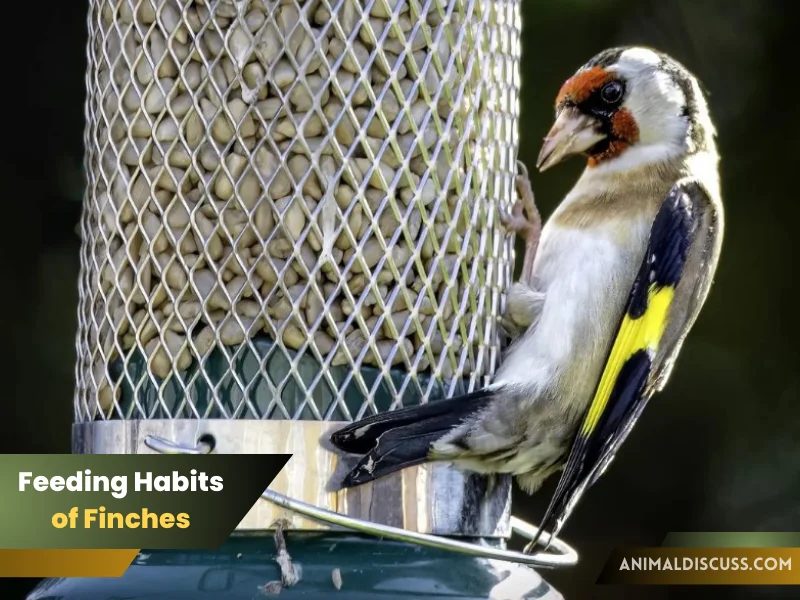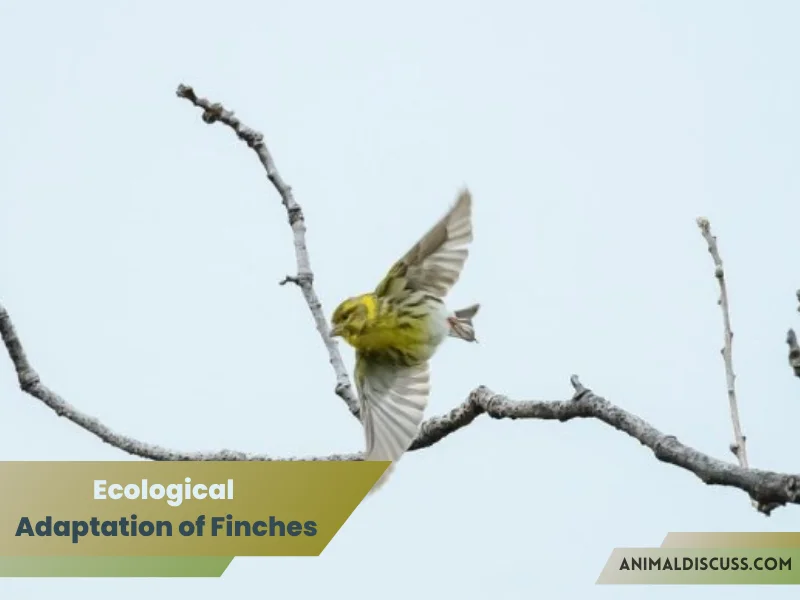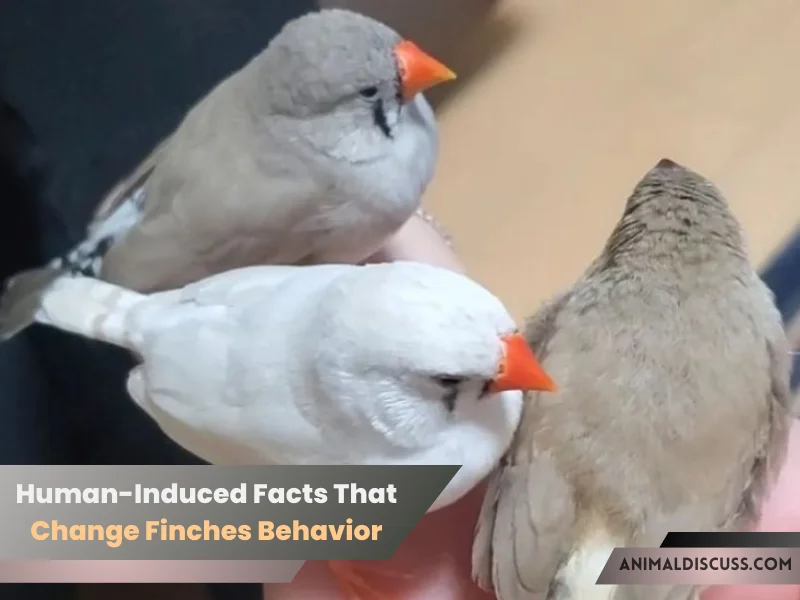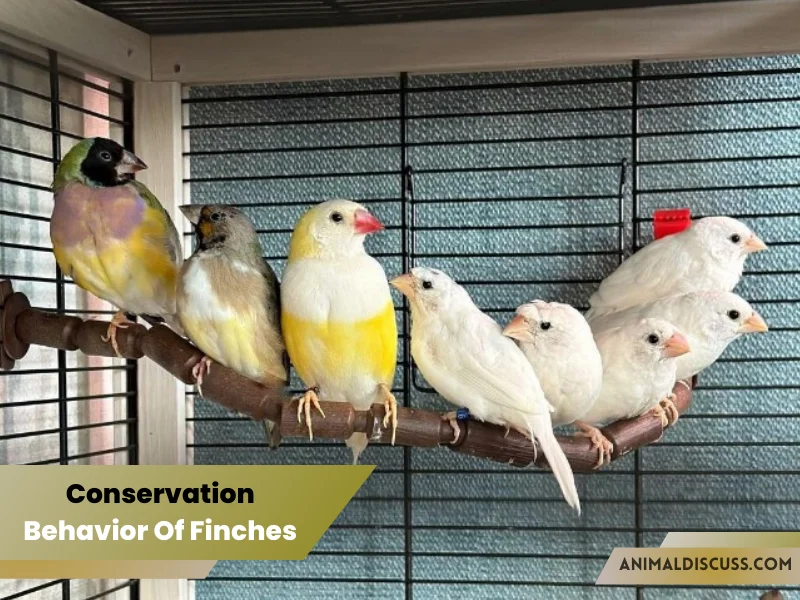During Darwin’s expedition to the Galapagos Islands in 1835, he observed that different finches species had adapted to each island’s unique environmental conditions. Apart from their remarkable adaptability, finches have elaborate courtship displays during the mating period.
Additionally, finches are renowned for their unique beak shapes, which have evolved to suit various feeding habits, ranging from cracking open seeds to catching insects mid-flight. These intriguing facts highlight the intriguing nature of finches’ behavior.
Moreover, we will uncover a plethora of other interesting facts related to their growing habits, feeding habits, breeding and migration patterns, ecological adaptations, aggression and territorial habits, social behavior, and the factors influencing their behavioral traits.
By the end of this article, readers will have an in-depth comprehension of these remarkable birds and how to provide the best possible care for them.
An Overview Of Behavioral Facts Of Finches
Here is an overview of the diversified behavioral facts of finches. Before going deeper, you can get an overall idea about their behavior.
| Behavioral Categories | Summary |
|---|---|
| Growing habits | 01. The size and weight of finches vary among species. On average, they range from 4 to 8 inches in length and weigh between 0.4 to 1.4 ounces. 02. Juvenile finches have a muted appearance, with duller feathers and less distinct markings compared to adult finches. |
| Feeding habits | 01. Finches have diverse feeding habits, including granivore, nectarivorous, insectivory, and omnivory. 02. Some species also show special adaptations, such as tools used to extract insects from bark or flowers. |
| Breeding & Migration Patterns | 01. Most finches have a breeding season that coincides with the availability of food and nesting materials. 02. Migration patterns of finches also vary depending on the species and their range. Some finches are non-migratory and remain in their breeding range year-round. |
| Ecological adaptation | Finches play important roles in their ecosystems, including pollination and dispersal. |
| Aggression & Territorial Habits | Finches exhibit various forms of aggression, including territorial defense and resource competition. |
| Social Behavior | 01. Finches are social animals, and some live in flocks. Also, during the breeding season, finches may exhibit social behavior to attract mates or defend their territory. 02. Familial relationships, mating patterns, and environmental conditions influence Finch’s social behavior. |
Growing Habits: Structural & Physical Adaptations of Finches
Finches exhibit various growing habits influenced by genetic and environmental factors. These habits can differ from one species to another and change throughout their lifetime. Let us look at some of these behaviors.

Structural & Physical Characteristics
Here are the structural and physical characteristics of finches.
1. Size And Weight
Finch sizes depend on the species, with the smallest being the bee hummingbird (Mellisuga helenae) which weighs less than 5 grams. It has a body length of about 6 centimeters.
The largest, on the other hand, is the hawfinch (Coccothraustes coccothraustes). This can weigh up to 50 grams and have a body length of up to 20 centimeters.
The finches’ size and weight are influenced by various factors, including their diet and habitat. For example, finches in open habitats like grasslands or deserts tend to be smaller and lighter than those in forested or montane habitats.
2. Color
The finch’s gender often dictates its color. For example, male fiches display bright colors during mating season to attract mates.
This phenomenon is known as sexual dimorphism, which is common in species where males play a more active role in courtship and mating. On the other hand, female finches have duller, more subdued colors.
3. Tails
Tail morphology varies greatly between finch species. For example, long-tailed finches (Poephila acuticauda) have distinctive, slender tail that is longer than its body.
On the other hand, house finches (Haemorhous mexicanus) have short, notched tails. Flight style, habitat, and breeding habits can all impact tail shape and size.
4. Wings
The wing shapes and sizes of different finch species are adapted to their specific flight mode. Some finches, for example, have long, pointed wings adapted for fast, efficient long-distance flight, whereas others have short, rounded wings that allow for more maneuverability in dense vegetation.
5. Growing Lifecycle
Like most birds, the growing cycle of finches can be divided into several distinct stages. Changes in physical appearance, behavior, and developmental milestones characterize each stage. Here is an overview of the typical growing cycle of finches:
Egg Stage: The growing cycle of finches begins when the female bird lays her eggs. The number of eggs a finch lays is between 2 and 10. The incubation period typically lasts between 11 to 15 days.
Hatchling Stage: After the incubation period, the eggs begin to hatch. To crack open the shell, the hatchlings use a small bump on their beak known as an egg tooth. Hatching can take several hours. Once hatched, the baby finches, known as chicks, are completely reliant on their parents for warmth, protection, and food. This stage lasts for 12-14 days.
Nestling Stage: As the chicks grow, they enter the nestling stage. The parents diligently feed them regurgitated food that is high in proteins and other nutrients necessary for their development. The foods include weed seeds, sunflower seeds, dandelion seeds, etc. The mothers smash the seeds and then feed them to their babies.
The chicks’ eyes open, and they begin to develop feathers. A nestling stage lasts about 28 to 35 days old.
Fledgling Stage: Once the chicks grow feathers, they enter the fledgling stage. As the nestlings grow, they acquire a complete set of feathers. Feathers aid in body temperature regulation and flight. The parents gradually reduce feeding and encourage the chicks to practice flying in preparation for fledging or leaving the nest. Fledgers are about 42 to 49 days old.
Juvenile Stage: After the fledgling stage, the finch chicks enter the juvenile stage. They continue to develop their flight skills, gradually becoming more independent. The parents teach them essential survival skills, such as finding food sources and avoiding predators.
Adult Stage: As the young finches mature, they acquire their adult plumage and reach sexual maturity. The timing for reaching adulthood varies among species and can take several months to a year. Once they are fully grown, the finches are capable of breeding and producing offspring of their own, thus completing the cycle.
Special (Evolutionary) Adaptations
Finches have developed a variety of specialized adaptations to help them survive in their respective environments. These adaptations are closely related to their growth habits and vary greatly between species. Among the most notable adaptations are:
Hearing development: Some finch species, like the Grasshopper Sparrow, have evolved specialized auditory adaptations that allow them to hear high-pitched frequencies. This is necessary for finding food and detecting predators.
Mark development: Many finches, such as the Zebra Finch, develop distinct markings on their feathers as they grow. These markings aid in attracting mates and signaling their reproductive status to other members of their species.
The darker, more pronounced black and white striped pattern on their chest helps to enhance their visibility to females and signal their fitness as potential mates.
Special kinds of development for particular finches: The Darwin’s Finch, found only on the Galapagos Islands, has evolved unique beak shapes that allow them to eat different types of food depending on the availability of resources on their specific island.
Habitat, Range, and Habitual Differences Among Species
Finches prefer to live in areas with vegetation that provides food, shelter, and nesting sites. Here are the differences between the different species of different habitats.
| Habitat | Range | Habitual Differences Among Finch Species |
|---|---|---|
| Arid Deserts | North America, South America, Africa, Australia | Some finch species have specialized beaks for extracting water from cactus plants. Example: Cactus Finch with a long, narrow beak. |
| Grasslands | North America, Europe, Asia, Africa, Australia | Ground foragers with strong beaks capable of cracking open seeds and nuts. Example: Ground Finch |
| Forests | North America, South America, Europe, Asia, Africa, Australia | Evolved plumage that blends with foliage for camouflage. |
| Islands | Galapagos Islands, Hawaiian Islands | On isolated islands, finches have adapted beak forms for specific food sources. Example: Galapagos/Darwin Finch with a long, curved beak for extracting insects from tree bark fissures. |
Feeding Habits of Finches
Finches’ different feeding habits include the following.

1. How They Feed The Young
Finches feed their hatchlings regurgitated food: insects, worms, and small invertebrates. Some finches also feed their young with seeds, fruits, and nectar.
2. Feeding Society
Feeding in flocks helps them to find food more easily and protects them against predators. In some species of finches, individuals take turns to feed, while in others, the dominant male takes the lead in feeding, followed by the rest of the group.
3. Hunting Tactics
Finches do not engage in active hunting behavior in the same way as predatory birds. However, some species, such as the crossbill and the redpoll, have specialized beaks that allow them to probe into tree bark or pine cones to extract insects or seeds.
The vampire finch even feeds on the blood of other birds by pecking at their feathers until they draw blood. Other feeding tactics include pecking, hammering, and gleaning.
4. Special (Evolutionary) Adaptations Of Feeding Habits
Besides their typical feeding habits, finches have acquired special adaptations that allow them to thrive in their habitats. These modifications include:
Beak Size: Finches that feed on large seeds have developed large, sturdy beaks that can crack open the tough outer shell of the seeds. Finches that feed on insects have a smaller, more pointed beak that helps them catch insects in flight or on the ground.
Tongue Structure: Some finches, like the Hawaiian honeycreeper, have developed lengthy, brush-like tongues for extracting nectar from flowers.
Unique hunting tactics: The yellow warbler searches for caterpillars by looking for holes in leaves made by the caterpillars. Then they remove the caterpillars from the leaves.
Hearing adaptation: Finches have highly developed auditory systems that help them locate food sources and detect predators. Their ears are behind their eyes and are covered with feathers protecting them from wind and noise.
Foraging techniques: For example, the Woodpecker finch uses a “stick tool” to extract insects from crevices in trees.
Whatever, want to know more about finches bird? Click on this article for more information.
Breeding (Mating) Habits & Migration Patterns
Breeding and migration play a crucial role in the survival and evolution of the species. Here are breeding habits, and the migration pattern of finches are described below.

1. Breeding Season
Generally, most finches breed during the spring (April or May) and summer (December or January) when the weather is warm and food abundant. Some species, such as the Zebra Finch, breed all year round.
2. Courtship Rituals
Finches have complex courtship rituals that involve singing, dancing, and displays of colorful plumage. The male finch often sings a distinctive song to attract a female mate. The courtship ritual can take several days or weeks, and the male finch will continue to woo the female until she agrees to mate.
3. Monogamy
Many finch species are monogamous, meaning they form pair bonds with a single mate during the breeding season. The pair usually stays together for the duration of the breeding season, and in some cases, they may even maintain a long-term pair bond.
4. Migration
Migration is another important behavior in finches. Some finch species migrate, while others are resident and do not migrate.
The Arctic redpoll, for example, has thousands of miles of migration routes. They migrate from their Arctic breeding grounds to wintering grounds in the southern United States or Mexico.
Other species, such as the house finch, are sedentary and do not migrate.
Some finches have also evolved special adaptations to help them migrate. The yellow-rumped warbler, for example, can digest wax esters found in palm tree fruits. Because of this adaptation, they can feed on these fruits while migrating when other food sources may be scarce.
5. Special (Evolutionary) Adaptations
Here are some evolutionary adaptations of finches’ breeding behaviors.
Plumage: Many species of finches have brightly colored feathers that they use to attract a mate.
Nest Building: For example, the Gouldian finch has a unique breeding habit where the males will court and try to attract a female by building intricate nests. The female will choose the male with the best nest and display, then lay her eggs in that nest.
Brood parasitism: Some finch species, such as the cowbird finch, have evolved a novel reproductive strategy known as brood parasitism.
Females will lay their eggs in the nests of other bird species, leaving the host species to raise their young. This behavior allows cowbird finches to conserve energy and increase their reproductive success.
Ecological Adaptation
Ecological adaptation refers to finches’ interactions with the environment, both living and nonliving, providing information on finch behavior. Finch species have evolved unique adaptations allowing them to survive and thrive in their habitats. But first, let us look at their role in the ecosystem.

Role In EcoSystem
Some common roles of finches in the ecosystem include:
Seed Dispersal: Finches play an important role in seed dispersal in many ecosystems. As they forage for seeds, they may inadvertently carry them to new areas and help spread plant species. In some cases, finches may even be the primary seed disperser for certain plant species.
Pollination: While not as effective as other pollinators like bees or butterflies, finches may still visit flowers and transfer pollen between them.
Insect Control: Some finches, such as the warbler finch, have been observed eating insects and other arthropods. This can help control pest populations and reduce crop or plant damage.
Food For Other Animals: As with many other small animals, finches’ presence in the ecosystem helps support the food web and maintain biodiversity.
Bioindicators: Finches can also serve as bioindicators of ecosystem health. Changes in their populations or behavior can indicate shifts in environmental conditions, such as habitat loss or pollution.
Ecotourism: In some areas, finches can be a draw for ecotourism. This can benefit local communities economically and help support conservation efforts for the birds and their habitats.
Ecological Adaptations Of Finches
01. Beak morphology: Finch beaks have evolved to match the types of food available in their habitats. For instance, the beaks of ground finches are adapted for cracking seeds, while the beaks of tree finches are designed for probing flowers and fruits.
02. Camouflage: Some species of finches have evolved to blend in with their environment to avoid predator detection. For instance, the cactus finch has a brown color that matches the cacti it inhabits.
03. Diet: Finches have a diverse diet, with species occupying niches as seed-eaters, insectivores, nectar-feeders, or frugivores. Finches’ various dietary strategies allow them to efficiently exploit specific food sources while reducing competition among species in the same ecosystem.
04. Migration: Many finches have evolved to migrate to different habitats during different seasons. This enables them to find food and shelter during different times of the year.
05. Vocalizations: These play a crucial role in the ecology of finches. These birds have developed intricate vocal repertoires and distinct songs that serve various purposes such as species recognition, during mating season, and to show social hierarchy.
Aggression And Territorial Habits
Finches are known for their aggressive and territorial behavior, especially during the breeding season. Let us delve deeper into the aggression and territorial habits of finches.

Predator-Prey Dynamics
Predator-prey dynamics influence finch aggression. Finches will attack and chase away predators who come too close to their nest or territory.
Territorial Behavior
Territoriality is the tendency of finches to defend and maintain a particular area as their own. Male finches establish territories during breeding by singing and displaying their plumage to attract females.
Once a female has chosen a male and mated, the pair will work together to defend their territory from other males. This behavior ensures that the pair has exclusive access to resources such as food and nesting sites, increasing their chances of successful reproduction.
Aggression
Aggressive behavior is an important aspect of finch territoriality. Male finches often engage in aggressive displays toward other males to establish dominance and defend their territory. These displays include singing, calling, and physical attacks such as pecking and wrestling.
Aside from that, they show some special kinds of territorial and aggressive behaviors.
Physical Displays: Finches may use physical displays to establish dominance and communicate with other finches. For example, males may puff up their feathers, raise their wings, and display their bright colors to attract females and intimidate other males. They may also engage in bill-fencing, touching bills with their opponent to display dominance.
Mobbing: Finches may also use mobbing, attacking a predator or intruder in a large group. This behavior is especially common when a predator threatens their nest or young. They may dive-bomb the predator or attack it with their beaks and claws, making it difficult for the predator to attack them.
Social Behavior
Another intriguing aspect to investigate is finch social behavior. These birds are known for their complex and diverse social structures, which differ greatly between species. Finches’ social habits are critical to their survival because they allow them to communicate and interact with one another effectively.

General Social Habits
01. Flocking: Depending on the species and season, flocks can consist of a few or hundreds of birds. Flocks are often formed during the breeding season, migration, and foraging. Flocking provides safety in numbers and helps finches find food and mates more efficiently.
02. Vocalizations: Vocal communication is crucial for social behavior in finches. Vocalizations are used for different purposes, such as territorial defense, courtship, and communication within the flock. Vocalizations also differ between males and females and can vary depending on age and social status.
03. Cooperative Breeding: In some finch species, individuals other than the breeding pair will assist with raising the young. This cooperative behavior often occurs in flocks with a dominant breeding pair, and helpers will assist with incubation, feeding, and protecting the young.
04. Social Hierarchies: Some finch species have complex social hierarchies, with dominant male finches controlling access to resources such as food and mates.
Special (Evolutionary) Adaptations
Plumage variation in finches is often used for social communication. Some species, such as the Gouldian finch, have strikingly different color morphs within the same population. This variation can be used for mate selection and to communicate social status within the flock.
Factors That Influence Different Behavioral Traits
Here are some factors that influence finches’ behavioral traits.
01. Environmental Factors
The environment in which finches live also affects their behavioral traits. For example, finches living in areas with limited food resources tend to be more aggressive and territorial as they compete for resources.
Similarly, finches living in areas with harsh weather conditions may have different feeding habits to cope with the challenging environment.
02. Social Influences
Finches are social animals, and the behavior of other group members influences their behavior. For example, a finch that grows up in a group with aggressive individuals may become more aggressive as it matures.
03. Learning
Finches can learn from their experiences, which can also shape their behavioral traits. For instance, a finch that successfully hunts a particular type of prey may continue to hunt that type of prey in the future.
04. Physiological Factors
For instance, changes in hormone levels can cause changes in behavior, such as increased aggression during the breeding season.
05. Evolutionary Factors
Over time, finches have evolved various behavioral traits that have helped them survive in their respective environments. For instance, some finch species have evolved specialized beaks for cracking tough seeds, while others have evolved to have longer wings for migration.
06. Climate Change
Rising temperatures and shifting rainfall patterns can impact finch populations, including breeding and migration patterns. Climate change can also destroy habitats through melting glaciers, rising sea levels, flooding, and erosion which in turn affects finch breeding behavior.
Human-Induced Facts That Change Finches Behavior
Human-induced factors can significantly alter the behavior of finches and other bird species. These factors include

Habitat Destruction
This can disrupt the finches’ natural behavior patterns by destroying nesting sites, food sources, and migration routes. Deforestation is one of the most effective habitat destruction forms affecting finches as it reduces nesting areas and even food sources.
Water pollution can contaminate aquatic food sources such as insects and fish, affecting finch diets.
Human Pets
Cats can prey on finch eggs and chicks, reducing the number of offspring that survive to adulthood.
Noise Pollution
Noise pollution caused by humans, such as traffic and construction, can also impact finch behavior.
Finch communication is based on vocalizations, and noise pollution can make it difficult for finches to communicate with one another. This can affect their ability to mate and forage for food, resulting in behavioral changes and a population decline.
Conservation Of Their Behavior
Various conservation efforts can be undertaken to protect the behavior of finches. Some of these efforts include the following.

Habitat Restoration
Restoring Degraded Habitats: In cases where finch habitats have been degraded or damaged, habitat restoration efforts can help recover and improve these areas.
Restoration activities may involve reestablishing native vegetation, creating suitable nesting sites, and managing invasive species. Restored habitats can provide the necessary conditions for finches to express their natural behaviors.
Education and Awareness
Raising public awareness about the importance of these birds’ behavior can help to promote conservation efforts. Through educational programs, public outreach, and media campaigns, we can help people understand the value of bird behavior and the need to protect it.
Research and Monitoring
Researching the behavior of birds, including finches, can help to identify key threats and conservation priorities. Monitoring populations and tracking behavior changes also helps with conservation efforts and identifying areas that need attention.
Conservation Legislation
Enacting and enforcing laws and regulations that specifically protect finches and their habitats can play a significant role in their conservation. These regulations may address issues such as habitat destruction, hunting, trade, and disturbance.
Community Involvement
Involving local communities in finch conservation efforts can result in more long-term and effective results. Participating in habitat restoration, citizen science projects, and promoting alternative livelihood options that are compatible with finch conservation can help to foster a better chance for finches.
Final Words
The study of finches’ behavior unveils a fascinating world of intricate evolutionary processes and ecological adaptations. From their feeding habits to intricate social dynamics, finches display a captivating array of behaviors that are vital for their survival.
Furthermore, recognizing the significance of preserving finch behavior becomes critical. These behaviors are critical not only for the survival of finch populations but also for maintaining the delicate balance of ecosystems.
We can protect the behavioral repertoire of these remarkable birds for future generations by preserving their habitats, mitigating human-caused impacts, and promoting conservation efforts.
You can read more about the fascinating aspects of finch behavior in other journals, books, and even online.
Reference Links:
https://www.nwf.org/Educational-Resources/Wildlife-Guide/Threats-to-Wildlife/Habitat-Loss
https://www.journals.uchicago.edu/doi/abs/10.1086/284219
https://www.pbs.org/wgbh/evolution/library/01/6/l_016_02.html
Image Credit:
- Instragram.com

